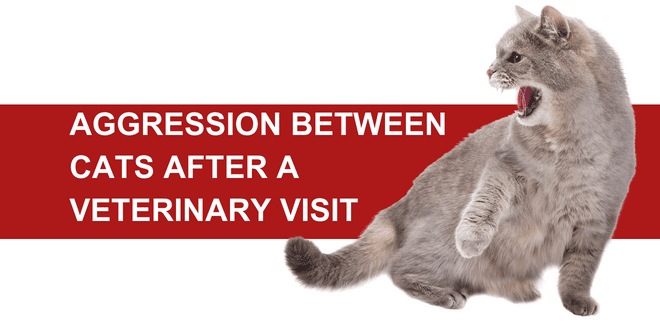
There’s a type of aggression that occurs between cats in the same household after a veterinary visit that can be easily prevented with a little planning. This is the kind of non-recognition aggression you may see when one cat comes home from the veterinary clinic and is either hissed at or actually attacked. For the unsuspecting cat parent (and for the victim cat) it’s terrifying because it comes out of nowhere and seems as if the cat who stayed home no longer recognizes their best friend. The fact is, the returning cat may look the same (in our eyes) but from a feline point of view, he isn’t recognized because he doesn’t smell the same. That may seem odd to a human but when you understand more about how important scent communication is in the feline world, you’ll see that this behavior, however frightening, is actually normal. Luckily though, you can take steps to prevent it.
The Importance of Scent
To better understand the scenario that takes place when the returning cat is attacked, you have to appreciate how cats communicate. They are masters at it and use vocalization, body language, visuals, and yes, scent! In fact, scent is arguably at the top of the list. Cats have 200 million scent receptors in their nasal cavity.
The pheromones (scent chemicals) cats give off from their scent glands provide other cats with a huge amount of information. Every time your cat rubs their cheek along an object they’re depositing a scent; when cats flank rub each other they are exchanging scents; when one kitty lovingly grooms another they combining scents. In a cat colony, this mixing of scents through allogrooming, flank rubbing, etc., is important to the security and peace of the group because it creates a communal scent.
Have you noticed how your cat may sniff your shoes or your clothes when you return home? That’s because you are carrying unfamiliar scents into the territory. If you were at a home with another cat, your cat will probably do some seriously intense sniffing to gather as much information as possible. So imagine how threatening it must be for the cat who stayed home to see a cat being let out of the carrier, into the territory, who is carrying unfamiliar scents. In fact, when it comes to not smelling like his normal self, the situation is made worse because the scents are those of a very threatening (from the cat’s perspective) place.
The returning cat doesn’t smell the same and actually is carrying scents that the returning cat associates with fear. Not many cats look forward to a visit to the veterinarian. Having your companion cat actually bringing those threatening scents into your territory? Time to panic!
The Offense and Defense
The cat who stayed home issues an initial attack. The returning cat doesn’t know where this came from and so there’s a defensive response. Well, now we have a two-way battle going on. There’s no way, at this point, either cat will stop and re-evaluate the situation and realize the true source of the aggression.
What can make the situation even worse is if the returning cat is already stressed out from the veterinary visit, is sick, recovering from an injury or illness, or not happy about having had to be in a car.
Preventing This Type of Aggression
- If the visit is for routine vaccinations or exams, schedule an appointment for both cats. That way they’ll both have a similar scent. You may still need to separate them upon returning home though since they may both be agitated.
- If you’re taking just one cat to the veterinary clinic, before leaving, take a pair of clean socks or a towel and gently rub him down, including around the cheeks, to collect the pheromones. Place the scented object in a plastic bag that you can seal. Keep that bag at home.
- When you return from the veterinary clinic, place the returning cat in a separate room and close the door. Take the socks out of the plastic bag and gently rub the cat down again to redistribute his familiar own scent. If the cat is agitated from having been at the veterinary clinic, save this step for later. Leave the cat alone in the room. This time alone will give the cat an opportunity to do some self-grooming so he can clean off more of the unfamiliar scents and redistribute his own, comforting scent. The time alone in the room will also give the cat a chance to acquire some of the normal household “scents” as well.
- A note of caution: do not take the socks and rub down the cat who stayed home. This will not end nicely. You definitely don’t want to distribute the veterinary clinic smell to any other cats. You also never want to force one cat’s scent onto another cat. Just take the towel or socks and place them in your washing machine.
- While the cats are separated, take the carrier and wash it out to remove the veterinary clinic smell.
- When you feel enough time has gone by and you want to reintroduce the cats, monitor their behavior until you’re sure everyone is back to normal. You can conduct an interactive play session, offer a meal, or offer treats for distraction. This might be the time to break out the super-special treats or the incredibly tasty food that you normally only offer on special occasions. If, however, the situation still seems tense, separate the cats again for a longer period and do a more gradual introduction.
Need More Information?
For more specific information on cat behavior and training in a multicat household, refer to the revised and updated edition of Pam’s best-selling book, Cat vs. Cat. You can find Pam’s books in bookstores and online. We’ve also included Amazon links here on our website.
If you have a question regarding your cat’s health, please contact your veterinarian. This article is not intended as a replacement for your cat’s veterinary care. This article is for information purposes only and not offering medical advice or providing a medical diagnosis.




